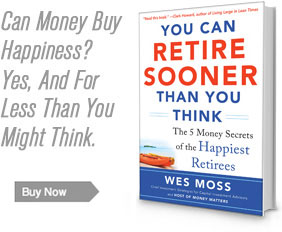
By Jonathan Chevreau
Here’s a blog I wrote for MoneySense.ca before the Hub launched, housed in what it now terms the MoneySense Findependence Archives. It seemed to resonate so I’ve repurposed it here, adding the cover shot of the book from which it’s drawn: You Can Retire Sooner Than You Think.
It deals with an interesting rule of thumb that most retirees and would-be retirees would do well to adopt. Developed by U.S. financial planner Wes Moss, it’s called the 1,000-Bucks-a-Month Rule. It means that for every thousand dollars in monthly income you want in retirement, you need to have saved $240,000.
So if you want $2,000 a month from your investment portfolio, this rule suggests you’d need to amass $480,000, which just happens to be close to the minimum amount ($500,000) that “happy retirees” in the United States tend to have saved up. Note this rule is to generate investment income that is above and beyond pension income, government pensions like Social Security (in the US) or the combination in Canada of CPP/OAS (Canada Pension Plan/Old Age Security).
This guideline suggests that if you want $4,000 a month from investment income, in addition to the usual alternative sources of income, then you need to have saved almost a million in liquid investments: $240,000 times four is $960,000. If you wanted $10,000 a month, then you’d need $2.4 million, etc. It also assumes you’re at least 60 years old, although it will be a useful benchmark even for those younger than 60 and who aspire to an early retirement.
Close connection to Bengen’s 4% safe withdrawal guideline
Moss uses this handy guideline in his practice (a George-based investment firm called Capital Investment Advisor, of which he is chief investment strategist) as well as on his popular financial radio show, Money Matters. It’s also his number one tip in his recently published book, illustrated above. The subtitle is The 5 Money Secrets of the Happiest Retirees, (McGraw Hill, 2014.)
So how does Moss arrive at this rule? It’s based on a 5% annual withdrawal rate, which means that $240,000 in investments would spin off $12,000 a year in some combination of interest, dividends and other income (which Moss calls distributions). Divide the $12,000 by the 12 months of the year and there’s your desired thousand bucks a month of income.
But 5%? Who can get 5% these days from bank deposits or even stocks? This is where it gets interesting.
Where does the 5% come from?
Note first that 5% is close to the 4% safe withdrawal rule made famous by financial planner William Bengen. He found retirees could withdraw 4% a year from a balanced portfolio and not run out of money for at least 30 years. (he includes an inflation adjustment but we’ll ignore that here).
Moss is a big fan of income investing so right off the bat you can get close to 5% in certain high-yielding dividend stocks (telecom or utility stocks for example, or REITs.) You’ll get perhaps 2 or 3% from fixed income, depending how much risk you want to take but what about the rest? How does Moss stretch Bengen’s 4% to 5% in this low-yielding world?
The rest comes from growth or capital gains, which year by year will fluctuate or even be negative, but over the long haul can be another 1 to 3% on top of the more assured yield from income investing. At worst, it may involve cutting slowly into capital but as long as your income investments are generating by themselves 3 or 4%, Moss assesses that such a nest egg would easily outlast the average 30-year retirement time frame.
There’s plenty of other stuff in the book but I’ll close with just two more points. Like myself, Moss believes retirees should have completely paid off their home mortgage. And he’s not a big fan of annuities.

